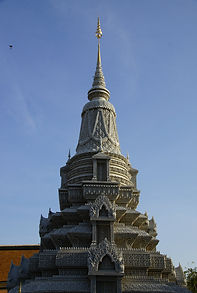
Phnom Penh and the Killing Fields
Next day we were on our way to the capital city and we were trying to learn how to pronounce it. The first thing we saw was the Royal Palace. It was like a fairy tale. The king actually still lives there, he is an older gentleman, unfortunately he never married and doesn’t have any kids, so everyone is worried that Cambodia will be left without a king one day. There are brothers and cousins, the succession however is not that simple in the kingdom of Kampuchea.
If you’re in the city one thing I can recommend a tuk-tuk ride. The traffic is crazy, it’s a miracle there are no accidents every five minutes. And although the clashes finished not that long ago, in 97, you have a feeling that the city has healed.

We also went to a Thai boxing competition. I have never watched any kind of boxing live so this was fascinating on many levels. I didn’t realize that the music that accompanies Thai boxing to help the fighters keep the rhythm, was played live. Another part of the excitement was that we got on Cambodian TV as the even was broadcasted nationwide. In regards to sport, I have actually noticed that a lot of people do different kinds of things outdoors, on the streets, in the parks. Maybe there weren’t that many people running, but aerobic, Zumba, tai-chi, badminton, yoga etc. People seem to enjoy exercising outside with other people.

Now the second day in Phnom Penh was the most difficult one on that trip. We were due to see the prison and the Killing Fields. It didn’t start so bad, I’ve seen Auschwitz couple of times and as hard as it was, I thought I was mentally prepared. Well it turned out you can never be prepared for something like that. Killing for no reason, cruelty that some people are capable of. I could never understand it and I don’t think I ever will. People murdering people. And for what? Power? It is beyond my understanding. Fanatism is beyond my understanding.
In the prison, that is now converted into a museum, we met two elderly gentlemen. Although I might be wrong about their age, because they used to be prisoners there. They were one of the last ones that have survived and are still alive. They sat there on a bench, chatted to people visiting and selling their books. As if they never left.
After the prison we went to the Killing Fields. I should have probably started with a historical explanation of why such site even exists. During the regime of the Khmer Rouge under Pol Pot people, mainly from ethnic minorities (Vietnamese, Thai, Chinese, Cham etc), would get warnings from the “police”. Receiving more than two of those warning meant “re-education”. During interrogations prisoners were encouraged to confess for example to contact with foreign governments or just any foreigners. They believed they would be forgiven after the confession and would be able to go home. Instead they were taken to places like Tuol Sleng in Phnom Phen and then tortured. Often executed.
The amount of people tortured and executed lead to mass graves. Very often to save ammunition poison was used, next to spades and bamboo sticks. It was also quite common to kill the children together with their parents to make sure they don’t seek revenge once they grow up. I’m not going to describe the many ways the Khmer Rouge have killed people. They are beyond disgusting. And again, my naivety about the human condition… I was convinced that after the Second World War we have learnt at least to respect human life.

I did say we have visited the Killing Fields, but it isn’t just one place. There are actually around 20 000 mass grave sites in Cambodia – the one we saw was a Buddhist remembrance site. It took a very long time for the country to heal. With the help of the UN some people who were responsible for the genocide ended up in prison, almost 20 years after the events.
Needles to say I think you’ll understand that I haven’t taken even one single picture there.
Royal Palace in Phnom Penh

View from the street






Describe your image.

